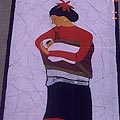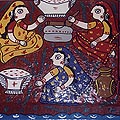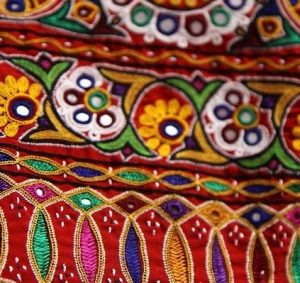Janakpur, a city in Nepal’s eastern terai, is a Hindu pilgrimage site with an ancient heritage. God Ram and goddess Sita are said to have been married there, and each year Janakpur celebrates Ramnawami (the birthday of Lord Ram) and Bibah Panchami (the marriage of Sita and Ram). People come to Janakpur from all over the world to see the Janaki Mandir, a temple dedicated to Sita. Janakpur was once the capital of a kingdom called Mithila (whose territory extended into the present day Indian state of Bihar) and it remains today the centre of Maithil culture in Nepal.
Most Maithil people live in small villages, usually with no more than around 100 households. House walls are made from bamboo or thatch, plastered with a mixture of cow dung and mud. The roofs are thatched, sometimes tiled, with most houses having a fenced courtyard constructed with mud and cow dung.
SOURCES
Maithil culture has its own language and rich literary traditions – as a part of this cultural and religious tradition, the women paint striking murals on the external walls of their homes, while in the homes pottery storage containers and internal mud pillars carry intricate designs. This (women’s) tradition of painting and craft has been passed down for generations and the villages near Janakpur showcase this living museum on the mud walls and homes.
Paintings are often derived from Hindu mythology – they can be derived from complex symbols (sometimes with a distinct mandala-like quality), represent abstract figures (including hand-stencils, peacocks, pregnant elephants, and fish), or contain a narrative quality (representing religious stories).

TRADITIONS
Different castes and different regions have developed distinctive styles and symbols, which are passed down from mother to daughter. Traditionally, painting and decoration is not undertaken purely to create an aesthetic result but largely springs from cultural and religious motives. The act of painting, as a part of a ritual has been considered more important than the finished result; completed paintings serve as charms, prayers, and meditation aids.
Painting traditions vary from caste to caste. High castes, including the Brahmins and Kayasthas, have developed extremely elaborate, abstract forms, while lower-caste paintings, though simpler and more realistic, possess an energetic expression, and retain a strong sense of formal design.
The art of Brahmins and Kayasthas is closely tied to religious ritual, as exemplified in the making of aripana. To make an aripana, the women grind rice and mix it with water to make a paste called pithar. Using their fingers, they create graceful, lace-like designs on the mud floor of homes and courtyard. Colour is added with the blood red vermilion powder (sindur) in the form of dot-like patterns.

A large repertoire of designs are drawn on for worship of household deities, for rituals related to marriage, and for marking auspicious days on the calendar. Brahmin women decorate a maraba, a pavilion made out of mud plaster, on the occasion of upanayan (a boy’s haircutting ceremony) with images of gods. On the occasion of weddings, Kayastha women pay special attention to the decoration of a wedding chamber called the kohbar. The kohbar is a room in the bride’s house where the couple will spend their first four nights together. It is decorated with an ornate tantric design, also called kohbar, consisting of a stylised central stalk of bamboo (symbolising the male) surrounded by circles that are lotus leaves (symbolising the female). The kohbar also contains parrots, images of happy union, and turtles and fish, which represent Vishnu’s incarnation and also male and female sexuality. Other images painted in the kohbar include parrots with bamboo, symbolic of the generations to come, Lord Shiva riding his bull, and Lord Krishna playing the flute in a kadamba tree, where he has mischievously hung the saris of the bathing maidens (gopis). On the wedding night, the bride and groom perform a ritual in which they apply sindur to the kohbar.

While the imagery of the Kayastha and Brahmin tradition is perhaps the more refined and religious in character, painting is done by all the castes. The villages around Janakpur are their liveliest at the time of the autumn festival of Deepawali. Just before Deepawali, women cover their houses with a smooth mixture of mud, dung, and rice husk. They form relief designs on the walls of the house and make decorations around the wood columns of their verandas. The night before Deepawali, when Laxmi, the goddess of wealth, is worshipped, they paint the house walls to attract a visit from the goddess. Pregnant elephants, symbolising prosperity, and auspicious peacocks are painted often.
During the dry months, women of all castes make large vessels called kothi out of mud, dung, and rice husk. These vessels are used for the storage of grain and lentils. Kothi are frequently built in the shape of turtle and fish. A typical kothi is square with five storage areas, and is called a panch (five) kothi. Often at least one room in the house is filled with large kothi that reaches almost to the ceiling. Shelving is fashioned out of mud, as are stoves for cooking with fire.

The art created by the women is transient. Rains destroy the mud and painted designs or in the spring, during a New Year festival called Jursital, paintings are covered over with mud.
INTERVENTIONS: MAITHIL PAINTINGS & THE JANAKPUR WOMEN’S DEVELOPMENT CENTRE
Maithil paintings from Madubani in Bihar (India) have been discovered by the international art world. Until fairly recently, little interest was taken in the art produced on Nepal’s side of the border. This changed with the foundation of the Janakpur Women’s Art Project (in 1989), with the dual aim of promoting traditional Maithil painting skills and empowering the women painters. The project is housed in the Janakpur Women’s Development Centre and it’s possible to visit the Centre to see the women working, and to buy what they produce.
The project includes women of diverse castes and backgrounds and the art that is created reflects this variety: wedding paintings, pregnant elephants, gods, and abstract tattoo designs are just some of the subjects. Increasingly the paintings are changing to include scenes from the women are also producing ceramics (plates and figures), papier mâché, patchwork tapestry, silk-screen prints, and woven wall hangings.

While the Kayastha caste has had a tradition of making paintings on paper to wrap gifts at the time of marriage, for most Maithil women the practice of painting on paper was fairly new. Janakpur is now famous for its colourful paintings on paper, yet this ‘tradition’ began in the first days of the JWDC when, under a grant from the Ella Lyman Cabot Trust, a talented group of women were selected to learn how to transfer their wall designs to paper. They travelled from their villages to the Centre in Janakpur where, without losing their originality, they developed skills in composition as well as in the use of colour and line. After various experiments, it was decided to paint on Nepali handmade lokta (Daphne) paper, which has the rough texture of mud walls. Then, after trying pens and sticks, the women decided on brushes, and after experimenting with their own dyes and pigments, which they mixed with milk, they found that acrylic paint worked best on Nepali paper and could be used as spontaneously as the dyes and home-made paints that were applied on house walls.
Since the establishment of the JWDC, the Maithil art of Nepal has developed in a different direction. Just as is characteristic of Madhubani art, figures are shown without perspective, often in profile and with large eyes. Natural images from wall paintings – such as leaves, lotus flowers, parrots, and fish – fill empty space in all types of scenes. Careful attention is paid to colour and pattern, as on a fish or a sari. The designs found around doors and windows or at the bottom of a wall are the designs that border the page. But just as bold, often humorous, designs were painted on their mud walls, now women paint with similar spontaneity on handmade Nepali lokta paper. These fresh, lively scenes on Nepali paper are today known as Janakpur art.
Proud of their traditional culture, the women continue to illustrate Maithil rituals or to make paintings of Ram and Sita who, according to legend, married in Janakpur. And in the ‘office’ where they sang songs or told tales of the Hindu gods, they naturally painted scenes from the Hindu epic Ramayana or from Maithil songs and folktales. Many women have enjoyed painting the Maithil tale of Anjur, a tale in which a new bride is made to do impossible tasks by her jealous sisters-in-law, and is helpeed, each time, by sympathetic birds or snakes. They often mix images of other tales in with Anjur’s tale, and similarly gods will appear in scenes of family planning. This mixing of themes is a reflection of the real world of the Janakpur artists today. Artists associated with the Janakpur Women’s Development Centre are earning recognition as some of the finest contemporary artists in Nepal.
The range of products now being produced include paintings, and painted products like cards, mirror frames, photo frames, wall hangings, boxes, etc.
Gallery
YOUR VIEWS
PRACTITIONERS: INDIA
Access 70,000+ practitioners in 2500+ crafts across India.
BIBLIOGRAPHY
10,000+ listings on arts, crafts, design, heritage, culture etc.
GLOSSARY
Rich and often unfamiliar vocabulary of crafts and textiles.
SHOP at India InCH
Needs to be written.




